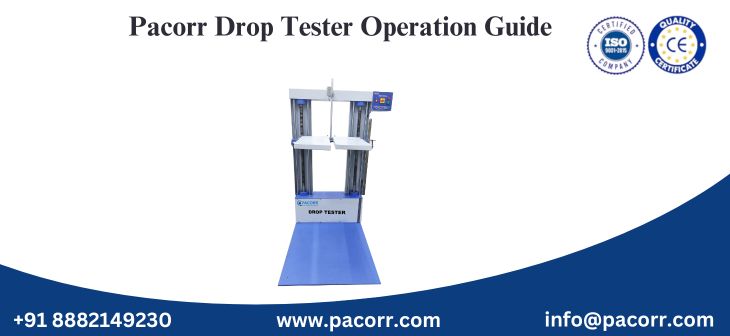
Pacorr’s Drop Tester Operation Guide provides an in-depth look at how drop testers work and how to use them effectively. In quality control labs for packaging and electronics, drop testers are essential equipment for simulating real-world drops and impacts that products and packages experience during handling and transit. This comprehensive guide offers technical insight into operating a drop test machine, applications in the packaging and electronics industries, pricing trends (including typical drop tester price ranges), and key factors in choosing a reliable drop tester manufacturer. The aim is to demonstrate expert knowledge (E-E-A-T: Experience, Expertise, Authoritativeness, Trustworthiness) for quality professionals seeking to improve product durability and packaging robustness through drop testing.
Understanding the Drop Tester and How It Works
A drop tester (also known as a drop test machine) is a specialized apparatus used to evaluate the durability of products and packaging by subjecting them to controlled free-fall drops. In a typical operation, the item to be tested (for example, a packed carton or an electronic device) is secured at a predetermined height on the drop tester. The device includes a release mechanism—often a platform, clamp, or support arm—that holds the specimen in place. When the test is initiated, the mechanism quickly releases the item, allowing it to free-fall and hit a solid impact surface (usually a steel base plate). This impact reproduces the shock and stress that the product or package would experience if dropped in real life.
Modern drop testers sometimes incorporate sensors and high-speed cameras to gather data during the drop. This instrumentation provides engineers with quantitative data (e.g., peak G-forces, impact duration) and visual evidence of damage modes, allowing analysis of weak points or failure areas in the product or packaging design. These tests are conducted under controlled conditions to ensure repeatability and adherence to industry standards, making the drop tester a trusted tool in package testing and product ruggedness testing.
Drop testers come in various designs and capacities. For packaging applications, common designs include the single-arm or dual-arm drop tester with motorized lifts. In contrast, electronic product testing uses guided towers or fixtures for consistent drops on corners or faces. All drop testers aim to release the specimen instantaneously, ensuring a true free-fall to verify compliance with standards like ASTM D5276 or IEC 60068-2-31.
Operational Guidance: How to Use a Drop Tester
1. Preparation and Setup
Calibrate and set the drop height on the machine. Ensure the impact surface is level and constructed of compliant material (steel or concrete).
2. Mounting the Specimen
Place or secure the test sample on the holding mechanism. Ensure it is properly aligned based on the test orientation (flat, edge, or corner).
3. Configuring Test Parameters
If the drop tester includes programmable settings, configure the number of drops, drop orientation, and sensors if applicable.
4. Performing the Drop
Trigger the release via lever, button, or pneumatic control. Let the item fall freely without obstruction. Maintain safety distance during operation.
5. Post-Drop Inspection and Data Collection
After each drop, inspect the specimen for visible damage and record any sensor data if applicable.
6. Repeat as Required
Perform multiple drops on various faces or corners per the applicable test standard.
7. Safety and Reset
Reset the machine to the start position and ensure it is safe for the next operation cycle.
Applications in Packaging Industry
In packaging, drop tester are used to evaluate the structural integrity of boxes, crates, and shipping containers. Simulating real-world handling and shipping scenarios, drop testers help determine:
- Resistance to drop impacts on corners, edges, and faces
- Cushioning effectiveness of inner packaging
- Overall package durability
Manufacturers often perform drop tests to meet ASTM D5276, ISTA Series, or ISO 2248 compliance requirements. These tests help identify packaging weak points and enable improvements in design and materials.
Applications in Electronics Industry
In electronics, drop testers are critical for product reliability testing. Devices such as smartphones, tablets, laptops, and wearables undergo drop tests to assess:
- Structural durability of casings
- Internal component resilience
- Impact tolerance of displays and connectors
Standards like IEC 60068-2-31 and MIL-STD-810H are commonly followed. Drop testers with high precision and repeatability are used in R&D and production validation labs to replicate real-world consumer handling.
Drop Tester Price: What to Expect
The drop tester price depends on factors such as:
- Type & design (single-arm, dual-arm, guided tower)
- Load capacity (lightweight electronics vs. heavy cartons)
- Release mechanism (manual, motorized, pneumatic)
- Additional features (sensors, software integration)
Estimated Price Range:
- Basic manual models: ₹70,000 to ₹1.5 lakhs
- Motorized packaging testers: ₹1.5 lakhs to ₹5 lakhs
- Advanced electronics testers with data logging: ₹2 lakhs to ₹10 lakhs
Prices may vary based on the drop tester manufacturer, region, and optional customizations.
How to Choose a Reliable Drop Tester Manufacturer
When selecting a drop tester manufacturer, evaluate the following:
- Experience & credibility in the testing equipment industry
- Compliance with standards like ISO, ASTM, IEC
- Customization options for test-specific needs
- After-sales support & calibration services
- Client testimonials and service network availability
Leading manufacturers like Pacorr offer high-performance drop testers tailored to diverse industrial applications, ensuring repeatable, standards-compliant testing.
Conclusion
Pacorr’s Drop Tester is a vital tool in ensuring that packaging and electronic products meet global standards for durability and safety. This blog outlines the technical understanding, step-by-step operation, industry-specific applications, and price guidance necessary for professionals to make informed decisions. By choosing the right drop tester and following best practices, manufacturers can enhance product quality, reduce returns, and build customer trust.
Thanks to Pacorr Testing instruments, we have all the required quality testing instruments that have helped us to ensure the best quality delivered to our clients.

Danish
Fair Exports Pvt. Ltd.

